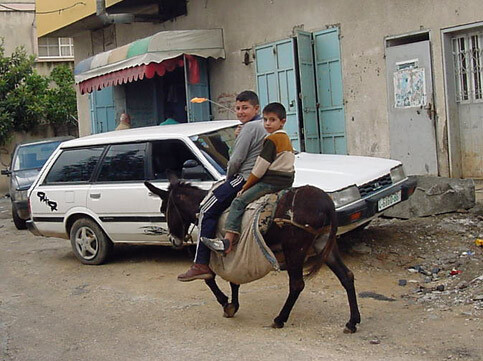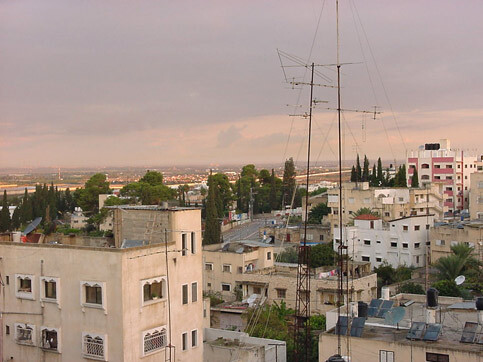
Entering the town of Tulkarem
1 November 2006 in Tulkarem
Dr. Imad was right! There is an Israeli military incursion happening right here right now, just as he said it would: in the refugee camp adjacent to the town of Tulkarem. And now they are in the main part of town right in front of us!
On the way to Qalqilya this morning, we drive right past three Israeli APVs in our mobile health van. Through our van’s front window, we see two soldiers crouched behind their APV with their semiautomatic rifles cocked; now they are running around the vehicle counterclockwise, and right into an apartment building. My camera is off, and I admit I am too startled to have the wherewithal to take a picture. This whole scene happens before us in a matter of seconds.

In the background, the Israeli settlements of Ginot Shomron, Karnei Shomron and Maale Shomron to the South of Kufr Lakif
We continue to drive on, so I can’t say for sure what happens after that. We pass two Israeli settlements and through an underpass, below a road which connects the two settlements on either side of our road. This road is behind fences, and off limits to Palestinians. We pass through a checkpoint and show our Palestinian ID cards and my US passport to the soldiers who react with their usual arrogance and distain. This is the only way for us into Qalqilya. I wish there was an easier way. We drop Dr. Imad off at the Qalqilya District Headquarters of PMRS and then head east to the village of Baka Al Hatab, the first of two villages that our Mobile Health Unit will visit today.
This village is perched high upon a hill. From a distance, the world seems peaceful. We look down upon olive trees, and to the west, you can see Israel, and make out the Mediterranean Sea. Most of the villagers are out in the groves harvesting their olives, so there are only a few patients for us to see today.
Dr. Osama and I pass the time reviewing how to take a medical history in Arabic. We review colloquial Arabic terms for congestion, cough, sore throat, fever, vomiting, diarrhea, pain, etc. I am finding that I am competent as a doctor seeing patients here as long as I have a translator. But my Arabic language skills are still nowhere near where they need to be in order for me to see patients independently. Dr. Osama does the translating; he and I are having fun comparing ideas on how we will manage the patients that we see.

Children gather around the Medical Relief van in Kufr Lakif
We see only a few patients here today in Baka Al Hatab; then we move on to the next village, Kufr Lakif. The southern border of this village is now penned in by three smaller Israeli settlements, Ma’ale Shomron, Ginot Shamron and Karnei Shomron, which are in the process of being merged by forceful land grabs into one big settlement. From the rooftop of the municipal building where were are holding our clinic, I can see an excavator and a CAT bulldozer carving the route of the Annexation Barrier right through the olive groves. Kufr Lakif’s mayor, who is on the rooftop with me, says that 2000 dunums, (about 500 acres) of the village’s land is now being confiscated by the settlements. Ancient olive trees are being ripped out of the ground for the barrier’s path. We see several more patients here, and then head back to Qalqilya to pick up Dr. Imad before we return home.
Dr. Imad gives me the news report about what we witnessed this morning in Tulkarem. The incursion started last night in the refugee camp. Then it spread to the main city itself. They are looking for an armed resistance fighter affiliated with Fateh, who they still have been unable to capture. Still, the IOF injured three and arrested two. When we saw them this morning, they were in the process of forcefully emptying an entire apartment building if its inhabitants. This is where their suspect lives, but they were unable to find him. They cut off the electricity to the entire city of Tulkarem for most of the day today. Now it is back on. These kind of collective punishment tactics, which violate the Forth Geneva conventions of international law, are quite typical of the IOF; they occur on a daily basis. The news from Gaza today is even more grim: the Israelis killed nine people and wounded 45 there today.

Donkey riders in Al Qufeen village
2 November 2006, in the villages of Qufeen and Akaba, north of Tulkarem
We set up our first clinic today in the village of Qufeen, population 9,000. This is a poor rural village whose main economy is agriculture and guest labor in Israel. The green line with Israel is very close. Workers sneak across the barrier to do menial jobs for their Israeli masters, and risk being arrested for doing so. Getting across to Israel in order to find work is getting more difficult by the day.
According to Dr. ‘Azzam, many girls in this village marry too young, at the age of 15 or so, and have many children. Education levels are low. This society is socially conservative and closely follows Islamic traditions. Here there is a high degree of support for Hamas.
In some ways, this reminds me of the socially conservative town of Omak, Washington where I come from; a macho cowboy mentality is prevalent there in my village, and has been a high level of support for George W. Bush compared to Seattle. Fortunately for us, this is now beginning to change. Even rural folks in America begin to see the folly of George “Dubya’s” ways.
I hope with every fiber of my being that this is not just wishful thinking! That we will move past the dark days of this evil administration, rejoin the community of nations, and stop going about these reckless military misadventures alone. Perhaps the people in these villages would suffer less if we could elect a president and a congress that would be willing to curtail the “attack dog” mentality of the current Israeli leadership that is causing so much suffering among Palestinian and Lebanese civilians.
One of Qufeen’s town elders gives me the sad story of this village: In 1948, 30 percent of the village’s land was confiscated and placed on the Israeli side, just over the hill to the West. After 1967, another 30 percent was confiscated, totaling 60 percent. Now the Harmish and Dutan settlements have been created on this side of the green line, and continue to take more land from this village. The Israelis built the annexation barrier once, and then tore it down; moving it a little to the west, when they realized their first annexation barrier included too many Palestinian villagers. On the way here, we drove along the ugly scar that this first attempt at annexation created upon this land.

On the way back to Tulkarem inside the Mobile Health van
We are now finished in Qufeen, and move to the next village: Akaba, population 170. This village is comprised essentially of one big family who are all interrelated. Rural villages like this have a higher degree of genetic diseases like Thalasemia because cousins often inter-marry.
In all, this district of the Palestine Medical Relief Society Mobile Health Unit serves 15 villages: seven in the Tulkarem region and eight in greater Qalqilya.
We finish in Akaba and head back to town. In the evening, Dr. Imad tells me that the IOF was back in Tulkarem today. They returned to the same apartment where we witnessed the assault yesterday to look again for their suspect. They still couldn’t find him, so they arrested his brother instead. They can now use him as a bargaining chip. Again, this violates the Geneva Conventions’ prohibition against collective punishment.

The view looking north out the window of the top floor of the women’s center, where I have been staying. The attack from the IOF occurred about an hour ago in the vicinity of the pink and white building on the upper right of the photo. The Apartheid wall can be seen to the left on the green line (for a change). Israel can be seen on the opposite side to the extreme left.
3 November 2006 in downtown Tulkarem, 4:15 am
0415: The roosters start crowing, the minarets start calling the faithful to prayer, and I awake. I am here on the top floor dormitory of the Women’s Center, where I have been staying these past four nights, alone. At night, I have had this whole building to myself. During the daytime, a kindergarten and school for developmentally delayed children with special needs is held downstairs. Today at 7:30 am, I will be returning to Ramallah. I start to finish my packing.
0445: I hear two very loud explosions and then the staccato of gunfire from a semiautomatic weapon. Another IOF incursion is underway here. I hear shouts of Allahu Akbar! (God is great) twice. It seems to be coming from a pink and white building three blocks to the north. I look down the street and see an Israeli Armored Personnel Vehicle, or APV, just one block away. I turn off the lights in this room and continue to listen and watch outside from the darkness. Now the APV passes just below my window, and I back away as it passes so they won’t see me. I hear stern shouts from a megaphone ordering someone to do something. I think the shouts are in Arabic, but with a distinct Hebrew accent.
0455: I hear another very loud explosion from the direction of the pink and white building and then another round of gunfire.
0500: I hear three low-pitched loud thuds and see a flash (mortar fire?). More shouts from the megaphone. More shouts in Arabic, “Allahu Akbar!”
0508: More megaphone in Hebrew this time; more roosters crowing and crickets chirping.
0513: More megaphone shouts
0526: Electricity is cut off in several buildings to the North. I check the electricity in our building: it still works.
0545: I think the Israeli Occupation Forces are gone now. I start to see people on the rooftops and out in the street. The skyline brightens as the sun begins to rise.
I am not sure exactly what happened here this morning, but I expect we will here about it in the news.
Dr. Bill Dienst is a rural family and emergency room physician from Omak, Washington, USA.



